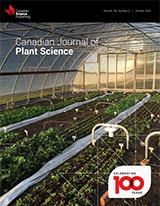
Peduncle breaking resistance: a potential selection criterion to improve lodging tolerance in oat
Journal Articles
Information
Peduncle breaking resistance: a potential selection criterion to improve lodging tolerance in oat
Authors: A. Nakhforoosh, S. Kumar, T. Fetch, and J. Mitchell Fetch
Read the Open Access paper: https://cdnsciencepub.com/doi/full/10.1139/cjps-2019-0286
Abstract
Breeding for tolerance to lodging is an objective, but also a challenge, in oat (Avena sativa L.) breeding programs. A widely adopted method to assess breeding lines for tolerance to lodging is based on visual scoring of plant standability (1 = standing upright; 9 = completely lodged). The lack of sufficient lodging pressure due to weather or growing conditions often renders the visual scoring method ineffective. We present an alternative approach that allows selection for tolerance to stem lodging by screening for peduncle strength in the absence of lodging pressure. This approach also provides objective selection of lodging tolerance using a quantitatively measurable plant trait rather than subjective scoring of the lodged plants. Stem structural and mechanical properties of six oat cultivars with varying levels of lodging tolerance were tested at field experiments over 3 site-years under three nitrogen rates. Results suggested peduncle breaking resistance (PBR), measured below the panicle, as a potential selection criterion for stem strength and therefore lodging tolerance. Significant genetic variation among oat cultivars (p < 0.01) was observed for PBR, which was significantly correlated with the strength of all lower internodes in all environments (R2 > 0.73, p ≤ 0.05). This suggests that PBR provides a good estimation of the whole culm strength. Phenotyping of PBR can be easily integrated into breeding programs because of the ease of sampling and rapid measurement.
Picture

